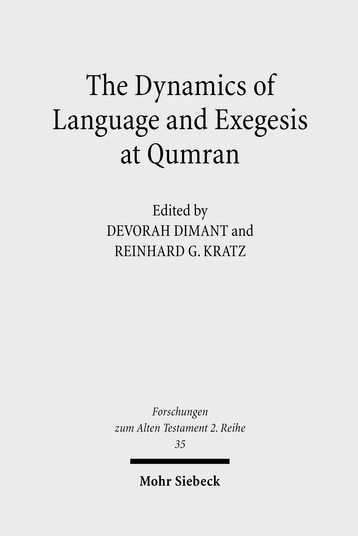Theology
The Dynamics of Language and Exegesis at Qumran
Ed. by Devorah Dimant and Reinhard Gregor Kratz
[Die Dynamik der Exegese und die Sprache in den Schriftrollen vom Toten Meer.]
Also Available As:
Published in English.
The discovery of the Qumran scrolls sixty years ago revolutionized our understanding of the development and exegesis of the Hebrew Bible. It became clear that both are mutually involved processes which started during the final stages of the Hebrew Bible and went on until its final canonization around 100 CA. Dated as they are between 300 BCE – 50 CA, the Qumran documents are placed precisely at the crucial stages of these developments. The recent publication of the entire collection of the scrolls illuminates these stages and opens new vistas on the early exegesis of the Hebrew Bible and its dynamics. In this volume, the authors deal with these issues in the light of the new material. Several articles trace the development from inner biblical interpretation to its follow-up in the scrolls and other ancient Jewish writings. Other contributions examine how various biblical narratives and figures are interpreted by the scrolls. The exegetical technique of the Pesharim, the particular interpretation of the biblical prophets, nurtured by the owners of the Qumran scrolls, is the subject of other discussions, while the relationship of the Book of Tobit and Qumran is the object of two of the studies in this volume.Survey of contents
I. Language and MethodsMoshe Bar Asher: Qumran Hebrew Between Biblical and Mishnaic Hebrew: A Morphological Study – George Brooke: New Perspectives on the Bible and Its Interpretation in the Dead Sea Scrolls – Annette Steudel: Dating Exegetical Texts from Qumran
II. Biblical and Related Writings
Ariel Feldman: The Story of the Flood in 4Q422 – Reinhard G. Kratz: Friend of God, Brother of Sarah, and Father of Isaac: Abraham in the Hebrew Bible and in Qumran – Jan Joosten: The Interpretation of Deuteronomy 29:17–20 in the Hellenistic Period: Septuagint, Qumran and Parabiblical Literature – Devorah Dimant: The Book of Tobit and the Qumran Halakhah – Ingo Kottsieper: »Look; son, what Nadab did to Ahikaros…«: The Aramaic Ahiqar Tradition and its Relationship to the Book of Tobit
III. Sectarian Writings
Anja Klein: From the 'Right Spirit' to the 'Spirit of Truth': Observations on Ps 51 and 1QS – Liora Goldman: The Exegesis and Structure of Pesharim in the Damascus Document – Peter Porzig: The Ark of the Covenant in the Non-Biblical Texts from Qumran
